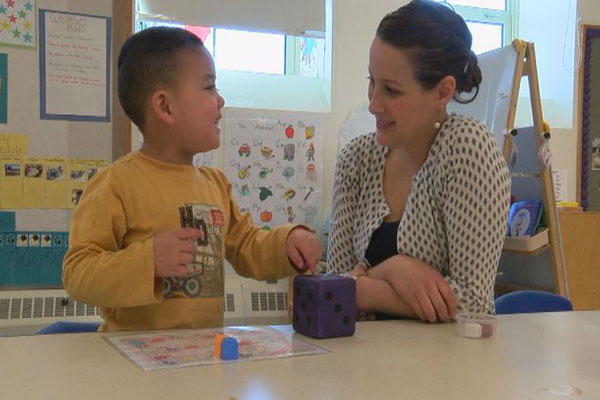Video Transcript for Recognition of Quantity
Dr. Sudha Swaminathan, Eastern Connecticut State University: Recognition of quantity is an important step in the counting sequence. This is when children have progressed beyond the number words. They know that a set of objects can be counted, they have a quantity. And they come to a point where they realize that, “Oh, I just know this is three.”
Narrator: The ability to immediately recognize a quantity is called subitizing. The word subitize comes from a Latin word meaning “suddenly.”
Child: Two.
Teacher: You’ve got two. Two bees.
Dr. Sudha Swaminathan: And this is when they make a perceptual, a visual connection to the numbers and they immediately know the total quantity…
Teacher: So how many blocks are on the plate?
Child: Four.
Dr. Sudha Swaminathan: Just by looking at a set of objects.
Teacher: How did you know that?
Child: Because I saw them.
How Can You Support Children to Recognize Quantity? (1:13)
Narrator: Adults can encourage children to recognize the quantity of objects in their immediate environment.
Child: I got three.
Teacher: Do you want three?
Supporting Math during Routines (1:29)
Narrator: Mealtimes provide opportunities for developing this ability.
Teacher: How many crackers can I have, Grace?
Child: Four.
Teacher: Four; you got four. Should I get four?
Narrator: Using picture labels at snack time can be especially useful.
Explicitly Teaching Math Concepts (1:51)
Teacher: Show me with your fingers.
Child: Look there, right there.
Narrator: Adults can plan intentionally to support children’s ability to recognize quantity. One strategy is to provide quick images of small sets.
Child: Green!
Children: Two! Two!
Teacher: There were two green cubes. Let’s check and see if you were right.
Children: Two!
Teacher: You were right.
Integrating Math Learning in Play (2:20)
Narrator: Board games are a great tool to support recognition of quantity.
Teacher: Where are you going to put it? What do you have?
Children: Four in a row!
Dr. Sudha Swaminathan: When they’re playing with dice, for instance, they have to recognize the number of moves that they can make.
Child: (rolls die)
Teacher: What did you get?
Child: Six.
Teacher: Six. You didn’t even have to count.
Dr. Sudha Swaminathan: As they get older, this becomes even more conceptual. Where they don’t recognize it as a visual arrangement, but they start to see groups. They might look at the six on the die, and realize that there are two groups of three, or there are three groups of two. Then they start to combine the groups and realize the total quantity.
© 2016 Connecticut Office of Early Childhood
Produced by the Center for Early Childhood Education at Eastern Connecticut State University.
May be reprinted for educational purposes.



